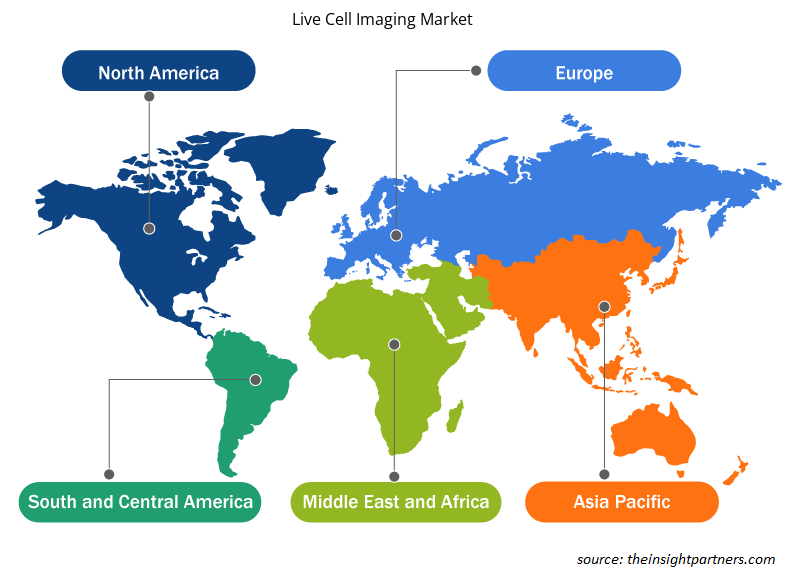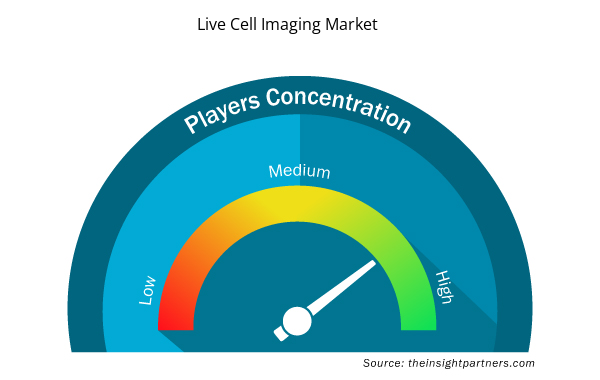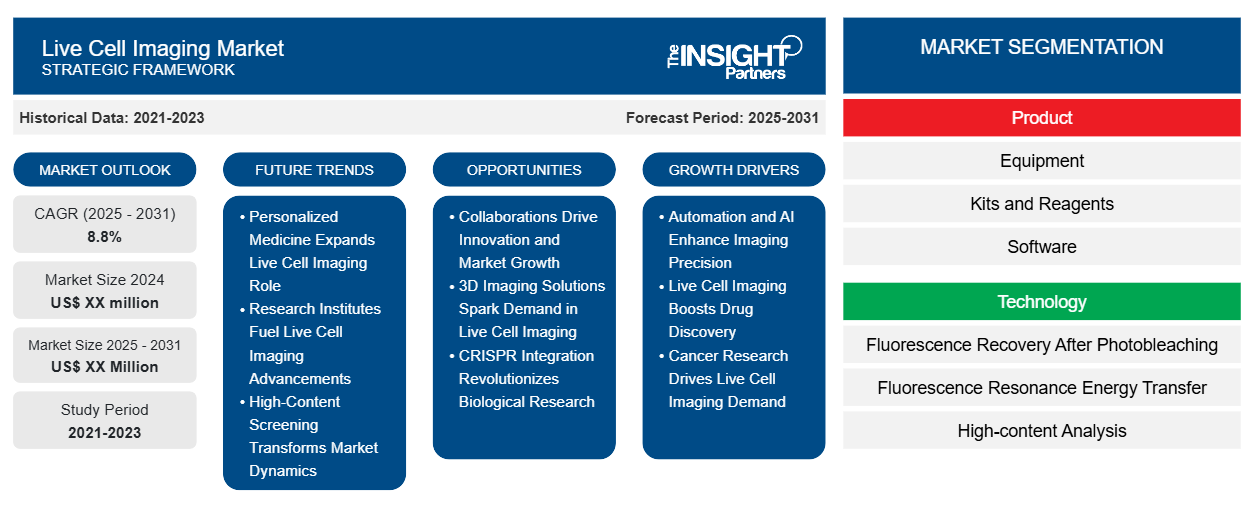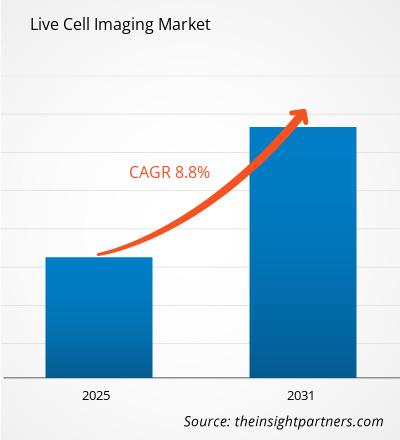Se espera que el mercado de imágenes de células vivas registre una CAGR del 8,8 % entre 2023 y 2031, con un tamaño de mercado que se expandirá de US$ XX millones en 2023 a US$ XX millones en 2031.
El estudio de mercado de imágenes de células vivas analiza las tendencias clave y los principales actores del mercado. El informe también cubre el análisis por producto, tecnología, aplicación, usuario final y geografía.
Propósito del Informe
El informe Live Cell Imaging Market de The Insight Partners tiene como objetivo describir el panorama actual y el crecimiento futuro, los principales factores impulsores, los desafíos y las oportunidades. Esto proporcionará información a diversas partes interesadas del negocio, como:
- Proveedores/fabricantes de tecnología: Para comprender la dinámica cambiante del mercado y conocer las oportunidades potenciales de crecimiento, lo que les permitirá tomar decisiones estratégicas informadas.
- Inversionistas: Realizar un análisis exhaustivo de tendencias sobre la tasa de crecimiento del mercado, las proyecciones financieras del mercado y las oportunidades que existen en toda la cadena de valor.
- Órganos reguladores: Regular las políticas y vigilar las actividades del mercado con el objetivo de minimizar los abusos, preservar la confianza de los inversores y defender la integridad y la estabilidad del mercado.
Segmentación del mercado de imágenes de células vivas
Producto
- Equipo
- Kits y reactivos
- Software
- Consumibles
Tecnología
- Recuperación de fluorescencia después del fotoblanqueo
- Transferencia de energía por resonancia de fluorescencia
- Análisis de alto contenido
- Hibridación in situ con fluorescencia
- Otros
Solicitud
- Descubrimiento de fármacos
- Biología celular
- Biología del desarrollo
- Células madre
- Otros
Usuario final
- Empresas farmacéuticas y biotecnológicas
- Hospitales
- Laboratorios de diagnóstico
- Otros
Usuario final
- Empresas farmacéuticas y biotecnológicas
- Hospitales
- Laboratorios de diagnóstico
- Otros
Personalice este informe según sus necesidades
Obtendrá personalización en cualquier informe, sin cargo, incluidas partes de este informe o análisis a nivel de país, paquete de datos de Excel, así como también grandes ofertas y descuentos para empresas emergentes y universidades.
- Obtenga las principales tendencias clave del mercado de este informe.Esta muestra GRATUITA incluirá análisis de datos, desde tendencias del mercado hasta estimaciones y pronósticos.
Factores impulsores del crecimiento del mercado de imágenes de células vivas
- La automatización y la inteligencia artificial mejoran la precisión de las imágenes: las tendencias recientes en automatización e inteligencia artificial mejoran aún más la precisión de las imágenes. Esto se verá resucitado por el desarrollo continuo de sistemas de imágenes de alta resolución y técnicas cada vez más avanzadas, como la microscopía de fluorescencia, para un análisis celular más preciso en apoyo del descubrimiento de fármacos y la investigación de enfermedades. Por lo tanto, los investigadores se están centrando en los conocimientos celulares en tiempo real que impulsan el crecimiento del mercado global impulsado por la demanda de tecnologías de vanguardia que impulsan su participación en el mercado y transforman la cara de la investigación científica en todo el mundo.
- La obtención de imágenes de células vivas impulsa el descubrimiento de fármacos: la mayor adopción de esta tecnología en el descubrimiento y desarrollo de fármacos es uno de los principales impulsores del crecimiento del mercado de la obtención de imágenes de células vivas. Permite la visualización de las respuestas celulares en tiempo real, que es uno de los elementos esenciales para llevar a cabo evaluaciones de la eficacia y toxicidad de los fármacos. Los análisis de mercado indican que las empresas farmacéuticas han invertido significativamente en la obtención de imágenes de células vivas para acelerar los procesos de desarrollo y obtener mejores resultados en los tratamientos. A medida que la medicina personalizada se ha afianzado, el tamaño del mercado es bastante amplio y permite que la obtención de imágenes de células vivas desempeñe un papel beneficioso en la configuración del futuro de los avances y la innovación en el ámbito de la atención sanitaria a nivel mundial.
- La investigación del cáncer impulsa la demanda de imágenes de células vivas: las imágenes de células vivas están cobrando importancia en los estudios sobre el cáncer para comprender el crecimiento tumoral, la metástasis y el comportamiento celular. Por lo tanto, la demanda de esta técnica aumentará a partir del monitoreo de las interacciones entre las células cancerosas y el microambiente. La creciente adopción de la oncología de precisión está fomentando el tamaño del mercado según los informes de mercado. Los investigadores están apuntando a estas técnicas para crear terapias contra el cáncer más dirigidas que cambien en gran medida las tendencias del mercado y generen mayores participaciones de mercado en los institutos de investigación y los proveedores de atención médica en todo el mundo.
Tendencias futuras del mercado de imágenes de células vivas
- La medicina personalizada amplía el papel de la obtención de imágenes de células vivas: la obtención de imágenes de células vivas se ha convertido en parte de la medicina personalizada debido a su creciente aplicación en diagnósticos y terapias. Las técnicas de obtención de imágenes avanzadas ofrecen tratamientos individualizados a través de conocimientos más profundos sobre los comportamientos celulares de diferentes pacientes. Las tendencias actuales del mercado están dominadas por las adaptaciones a través de cambios en las estrategias de los actores clave que involucran terapias dirigidas. El análisis FODA subraya la oportunidad de crecimiento en este sector en particular a pesar de que los altos costos de inversión siguen siendo un desafío. El análisis PEST insiste además en que los cambios demográficos benignos seguirán respaldando la demanda.
- Los institutos de investigación impulsan los avances en la obtención de imágenes de células vivas: EL MARCO ESTRATÉGICO/PESTEL: Los institutos de aprendizaje e investigación se están volviendo cada vez más expertos en la creación de tecnologías de obtención de imágenes de células vivas como insumo para promover la investigación en biología y medicina. Esto se debe a la colaboración con líderes de la industria y plataformas de obtención de imágenes de última generación. El análisis FODA dice que la innovación académica es una fortaleza, mientras que la falta de un presupuesto adecuado se considera una debilidad. Según el análisis PEST, los factores de crecimiento están bien financiados por el gobierno y tienen un fuerte apoyo político. Como resultado, la inversión en investigación por parte de dichas instituciones ha implicado que los actores clave comiencen a reajustar sus estrategias de mercado para dar cabida a dichas necesidades educativas.
- El cribado de alto contenido transforma la dinámica del mercado: el cribado de alto contenido se está adoptando cada vez más en el mercado de imágenes de células vivas debido a su potencial para analizar grandes conjuntos de datos de experimentos con células vivas. También ha transformado la dinámica del mercado, donde los actores clave están adoptando estrategias de mercado basadas en HCS para desarrollar una investigación eficiente. Las fortalezas se destacan a través del análisis FODA mediante la adquisición de datos de alto rendimiento a pesar de los desafíos en la interpretación de los datos. La creciente financiación gubernamental e institucional y la demanda de esta aplicación en los sectores académico y farmacéutico están impulsando la adopción en el mercado, según el análisis PEST.
Oportunidades de mercado en imágenes de células vivas
- Las colaboraciones impulsan la innovación y el crecimiento del mercado: la colaboración entre institutos de investigación y empresas de diferentes geografías está surgiendo como un factor crucial en el mercado de imágenes de células vivas. El análisis competitivo ha indicado que el 38% de los centros de investigación de América del Norte y Europa están colaborando en proyectos que utilizan imágenes de células vivas que propagan la innovación y el crecimiento. Esta tendencia ofrece oportunidades para que los líderes del mercado amplíen su presencia respectiva y adapten soluciones para satisfacer las necesidades de investigación colaborativa. De naturaleza global, estas asociaciones están remodelando la cara de la industria, en particular dentro de regiones de crecimiento como Asia-Pacífico.
- Las soluciones de imágenes 3D generan demanda en el campo de las imágenes de células vivas: las soluciones de imágenes 3D avanzadas y de alta resolución, especialmente en lo que respecta a estructuras celulares y tejidos complejos, tienen una gran demanda en el mercado de imágenes de células vivas. Esto abre una gran oportunidad para las empresas que desarrollan productos de imágenes 3D específicos. Las perspectivas de esta tecnología también están ganando atención en Europa, donde el enfoque en la investigación de precisión está revolucionando el panorama general de la industria.
- La integración de CRISPR revoluciona la investigación biológica: la integración de imágenes de células vivas con la edición genética CRISPR está revolucionando la investigación biológica, lo que supone una importante oportunidad de crecimiento. Esto genera un panorama competitivo positivo para las empresas que invierten en la integración con las geografías clave de Europa y Asia-Pacífico.
Perspectivas regionales del mercado de imágenes de células vivas
Los analistas de Insight Partners explicaron en detalle las tendencias y los factores regionales que influyen en el mercado de imágenes de células vivas durante el período de pronóstico. Esta sección también analiza los segmentos y la geografía del mercado de imágenes de células vivas en América del Norte, Europa, Asia Pacífico, Oriente Medio y África, y América del Sur y Central.

- Obtenga datos regionales específicos para el mercado de imágenes de células vivas
Alcance del informe de mercado de imágenes de células vivas
| Atributo del informe | Detalles |
|---|---|
| Tamaño del mercado en 2023 | XX millones de dólares estadounidenses |
| Tamaño del mercado en 2031 | US$ XX millones |
| CAGR global (2023 - 2031) | 8,8% |
| Datos históricos | 2021-2022 |
| Período de pronóstico | 2024-2031 |
| Segmentos cubiertos | Por producto
|
| Regiones y países cubiertos | América del norte
|
| Líderes del mercado y perfiles de empresas clave |
|
Densidad de actores del mercado de imágenes de células vivas: comprensión de su impacto en la dinámica empresarial
El mercado de imágenes de células vivas está creciendo rápidamente, impulsado por la creciente demanda de los usuarios finales debido a factores como la evolución de las preferencias de los consumidores, los avances tecnológicos y una mayor conciencia de los beneficios del producto. A medida que aumenta la demanda, las empresas amplían sus ofertas, innovan para satisfacer las necesidades de los consumidores y aprovechan las tendencias emergentes, lo que impulsa aún más el crecimiento del mercado.
La densidad de actores del mercado se refiere a la distribución de las empresas o firmas que operan dentro de un mercado o industria en particular. Indica cuántos competidores (actores del mercado) están presentes en un espacio de mercado determinado en relación con su tamaño o valor total de mercado.
Las principales empresas que operan en el mercado de imágenes de células vivas son:
- Termo Fisher Scientific Inc.
- Fabricante: PerkinElmer Inc.
- General Electric
- Corporación Olympus
- Instrumentos BioTek, Inc.
Descargo de responsabilidad : Las empresas enumeradas anteriormente no están clasificadas en ningún orden particular.

- Obtenga una descripción general de los principales actores clave del mercado de imágenes de células vivas
Puntos de venta clave
- Cobertura integral: el informe cubre de manera integral el análisis de productos, servicios, tipos y usuarios finales del mercado de imágenes de células vivas, proporcionando un panorama holístico.
- Análisis de expertos: el informe se compila sobre la base de un profundo conocimiento de expertos y analistas de la industria.
- Información actualizada: El informe asegura relevancia comercial debido a su cobertura de información reciente y tendencias de datos.
- Opciones de personalización: este informe se puede personalizar para satisfacer los requisitos específicos del cliente y adaptarse adecuadamente a las estrategias comerciales.
Por lo tanto, el informe de investigación sobre el mercado de imágenes de células vivas puede ayudar a abrir camino para descifrar y comprender el escenario de la industria y las perspectivas de crecimiento. Si bien puede haber algunas preocupaciones válidas, los beneficios generales de este informe tienden a superar las desventajas.
- Análisis histórico (2 años), año base, pronóstico (7 años) con CAGR
- Análisis PEST y FODA
- Tamaño del mercado Valor/volumen: global, regional, nacional
- Industria y panorama competitivo
- Conjunto de datos de Excel



Report Coverage
Revenue forecast, Company Analysis, Industry landscape, Growth factors, and Trends

Segment Covered
This text is related
to segments covered.

Regional Scope
North America, Europe, Asia Pacific, Middle East & Africa, South & Central America

Country Scope
This text is related
to country scope.
Preguntas frecuentes
The report can be delivered in PDF/PPT format; we can also share excel dataset based on the request.
Some of the customization options available based on request are additional 3-5 company profiles and country-specific analysis of 3-5 countries of your choice. Customizations are to be requested/discussed before making final order confirmation, as our team would review the same and check the feasibility.
Key companies in this market are: Thermo Fisher Scientific Inc, PerkinElmer Inc, General Electric, Olympus Corporation, BioTek Instruments Inc, Molecular Devices LLC, CYTOSKELETON INC, Bruker, Nikon Instruments Inc
The Live Cell Imaging Market is expected to register a CAGR of 8.8% from 2023-2031.
Key future trends in this market are - Advancements in microscopy technologies, Growth in drug discovery, Demand for real-time cell analysis
The major factors impacting the Live Cell Imaging Market are: Technological Advancements in Imaging Systems, Rising Demand in Drug Discovery and Development, and Growing Application in Cancer Research
Trends and growth analysis reports related to Life Sciences : READ MORE..
The List of Companies
1. Thermo Fisher Scientific Inc.
2. PerkinElmer Inc.
3. General Electric
4. Olympus Corporation
5. BioTek Instruments, Inc.
6. Molecular Devices, LLC.
7. CYTOSKELETON, INC.
8. Bruker
9. Nikon Instruments Inc.
10. Merck KGaA
11. Keyence Corporation
12. NanoLive SA
13. Sony Biotechnology Inc.
14. Phase Focus
15. Logos Biosystems (Aligned Genetics, Inc.)
The Insight Partners performs research in 4 major stages: Data Collection & Secondary Research, Primary Research, Data Analysis and Data Triangulation & Final Review.
- Data Collection and Secondary Research:
As a market research and consulting firm operating from a decade, we have published and advised several client across the globe. First step for any study will start with an assessment of currently available data and insights from existing reports. Further, historical and current market information is collected from Investor Presentations, Annual Reports, SEC Filings, etc., and other information related to company’s performance and market positioning are gathered from Paid Databases (Factiva, Hoovers, and Reuters) and various other publications available in public domain.
Several associations trade associates, technical forums, institutes, societies and organization are accessed to gain technical as well as market related insights through their publications such as research papers, blogs and press releases related to the studies are referred to get cues about the market. Further, white papers, journals, magazines, and other news articles published in last 3 years are scrutinized and analyzed to understand the current market trends.
- Primary Research:
The primarily interview analysis comprise of data obtained from industry participants interview and answers to survey questions gathered by in-house primary team.
For primary research, interviews are conducted with industry experts/CEOs/Marketing Managers/VPs/Subject Matter Experts from both demand and supply side to get a 360-degree view of the market. The primary team conducts several interviews based on the complexity of the markets to understand the various market trends and dynamics which makes research more credible and precise.
A typical research interview fulfils the following functions:
- Provides first-hand information on the market size, market trends, growth trends, competitive landscape, and outlook
- Validates and strengthens in-house secondary research findings
- Develops the analysis team’s expertise and market understanding
Primary research involves email interactions and telephone interviews for each market, category, segment, and sub-segment across geographies. The participants who typically take part in such a process include, but are not limited to:
- Industry participants: VPs, business development managers, market intelligence managers and national sales managers
- Outside experts: Valuation experts, research analysts and key opinion leaders specializing in the electronics and semiconductor industry.
Below is the breakup of our primary respondents by company, designation, and region:

Once we receive the confirmation from primary research sources or primary respondents, we finalize the base year market estimation and forecast the data as per the macroeconomic and microeconomic factors assessed during data collection.
- Data Analysis:
Once data is validated through both secondary as well as primary respondents, we finalize the market estimations by hypothesis formulation and factor analysis at regional and country level.
- Macro-Economic Factor Analysis:
We analyse macroeconomic indicators such the gross domestic product (GDP), increase in the demand for goods and services across industries, technological advancement, regional economic growth, governmental policies, the influence of COVID-19, PEST analysis, and other aspects. This analysis aids in setting benchmarks for various nations/regions and approximating market splits. Additionally, the general trend of the aforementioned components aid in determining the market's development possibilities.
- Country Level Data:
Various factors that are especially aligned to the country are taken into account to determine the market size for a certain area and country, including the presence of vendors, such as headquarters and offices, the country's GDP, demand patterns, and industry growth. To comprehend the market dynamics for the nation, a number of growth variables, inhibitors, application areas, and current market trends are researched. The aforementioned elements aid in determining the country's overall market's growth potential.
- Company Profile:
The “Table of Contents” is formulated by listing and analyzing more than 25 - 30 companies operating in the market ecosystem across geographies. However, we profile only 10 companies as a standard practice in our syndicate reports. These 10 companies comprise leading, emerging, and regional players. Nonetheless, our analysis is not restricted to the 10 listed companies, we also analyze other companies present in the market to develop a holistic view and understand the prevailing trends. The “Company Profiles” section in the report covers key facts, business description, products & services, financial information, SWOT analysis, and key developments. The financial information presented is extracted from the annual reports and official documents of the publicly listed companies. Upon collecting the information for the sections of respective companies, we verify them via various primary sources and then compile the data in respective company profiles. The company level information helps us in deriving the base number as well as in forecasting the market size.
- Developing Base Number:
Aggregation of sales statistics (2020-2022) and macro-economic factor, and other secondary and primary research insights are utilized to arrive at base number and related market shares for 2022. The data gaps are identified in this step and relevant market data is analyzed, collected from paid primary interviews or databases. On finalizing the base year market size, forecasts are developed on the basis of macro-economic, industry and market growth factors and company level analysis.
- Data Triangulation and Final Review:
The market findings and base year market size calculations are validated from supply as well as demand side. Demand side validations are based on macro-economic factor analysis and benchmarks for respective regions and countries. In case of supply side validations, revenues of major companies are estimated (in case not available) based on industry benchmark, approximate number of employees, product portfolio, and primary interviews revenues are gathered. Further revenue from target product/service segment is assessed to avoid overshooting of market statistics. In case of heavy deviations between supply and demand side values, all thes steps are repeated to achieve synchronization.
We follow an iterative model, wherein we share our research findings with Subject Matter Experts (SME’s) and Key Opinion Leaders (KOLs) until consensus view of the market is not formulated – this model negates any drastic deviation in the opinions of experts. Only validated and universally acceptable research findings are quoted in our reports.
We have important check points that we use to validate our research findings – which we call – data triangulation, where we validate the information, we generate from secondary sources with primary interviews and then we re-validate with our internal data bases and Subject matter experts. This comprehensive model enables us to deliver high quality, reliable data in shortest possible time.


 Obtenga una muestra gratuita de este informe
Obtenga una muestra gratuita de este informe